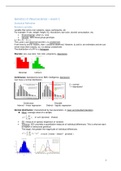College aantekeningen
Neurosciences year 1 - Genetics in Neuroscience (AM_1214) - summary lectures
Summary of lecture notes of exam 1 of the course Genetics in Neuroscience (AM_1214) from the master Neuroscience at VU Amsterdam. This is a VERY extensive summary on all the genetical models explained in this course.
[Meer zien]




